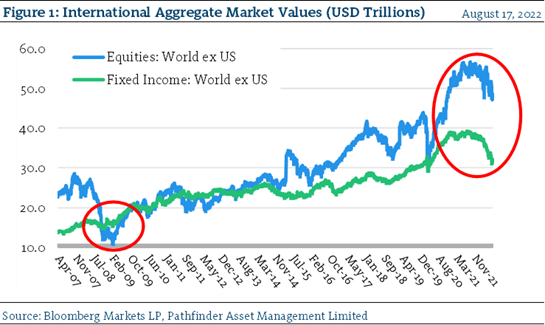The Great Global Balancing Effect
We continue with our aggregate market value series where we explore the change in financial assets across time and geographic regions. As a reminder, we had previously compiled various US equity, fixed income and crypto data to the end of June, and had been studying that data in various market stages. We expand the study this week to consider international data. In addition to various indices from FTSE Russell, Bloomberg Markets LP and CoinGeko, we have now added more Bloomberg indices that track aggregate non-US equity market value, fixed income data from Europe and Asia, and aggregate Global High Yield bond data. For this last piece of data, we manually removed US High Yield data to isolate the World ex-US information. We also converted, over time, all of the data to US Dollars so that we have like comparisons. The World ex-US data represents US$80.2 trillion in assets across 12,390 fixed income securities and 2,185 equity securities as of the end of June 2022.
- In Figure 1, we present world equity and fixed income data with the US removed from 2007 through June 30, 2022. Before the Great Financial Recession (GFR), total assets peaked in the fall of 2007 at US$43.8T and fell to a low of US$26.5T, for a total of US$17.3T in wealth destruction in international markets.

- The recent high for international assets in 2021 was US$94.8T, and as of the end of June had dropped to US$80.2T, for a loss of US$14.6T…. not as bad as the GFR, and on a percentage basis, not as bad as the drop in the United States for the same period (-15.4% vs. -20.3%).
- Much like the US data that we presented in our last issue of the series, we can see that for international markets, fixed income acted as a balancing effect during the GFR, but did not do so during this recent period. The major difference between the two periods for US and international data was the severity of the equities drop in global stocks during the GFR (-50.8% Intl vs. -59.0% US). For the most recent period, it appears that the wealth destruction from international stocks was not as severe as in the US.
“This means that” we will still hold onto our conclusions as we progress through the study, but there is a correlation between the behavior of financial assets and the two geographic areas (US vs. International). What we have clearly seen is the impact of diversification (both good and bad) on financial returns over time.
National Instrument 31-103 requires registered firms to disclose information that a reasonable investor would expect to know, including any material conflicts with the firm or its representatives. Doug Johnson and/or Pathfinder Asset Management Limited are an insider of companies periodically mentioned in this report. Please visit www.paml.ca for full disclosures.
*All returns are time weighted and net of investment management fees. Returns from the Pathfinder Partners’ Fund and Partners’ Real Return Plus Fund are presented based on the masters series of each fund. The Pathfinder Core: Equity Portfolio and The Pathfinder Core: High Income Portfolio are live accounts. These are actual accounts owned by the Pathfinder Chairman (Equity) and client (High Income) which contain no legacy positions, cash flows or other Pathfinder investment mandates or products. Monthly inception dates for each fund and portfolio are as follows: Pathfinder Core: Equity Portfolio (January 2011), Pathfinder Core: High Income Portfolio (October 2012) Partners’ Fund (April 2011), Partners’ Real Return Plus Fund (April, 2013), and Partners’ Core Plus Fund (November 2014).
Pathfinder Asset Management Limited (PAML) and its affiliates may collectively beneficially own in excess of 10% of one or more classes of the issued and outstanding equity securities mentioned in this newsletter. This publication is intended only to convey information. It is not to be construed as an investment guide or as an offer or solicitation of an offer to buy or sell any of the securities mentioned in it. The author has taken all usual and reasonable precautions to determine that the information contained in this publication has been obtained from sources believed to be reliable and that the procedures used to summarize and analyze such information are based on approved practices and principles in the investment industry. However, the market forces underlying investment value are subject to sudden and dramatic changes and data availability varies from one moment to the next. Consequently, neither the author nor PAML can make any warranty as to the accuracy or completeness of information, analysis or views contained in this publication or their usefulness or suitability in any particular circumstance. You should not undertake any investment or portfolio assessment or other transaction on the basis of this publication, but should first consult your portfolio manager, who can assess all relevant particulars of any proposed investment or transaction. PAML and the author accept no liability of any kind whatsoever or any damages or losses incurred by you as a result of reliance upon or use of this publication.